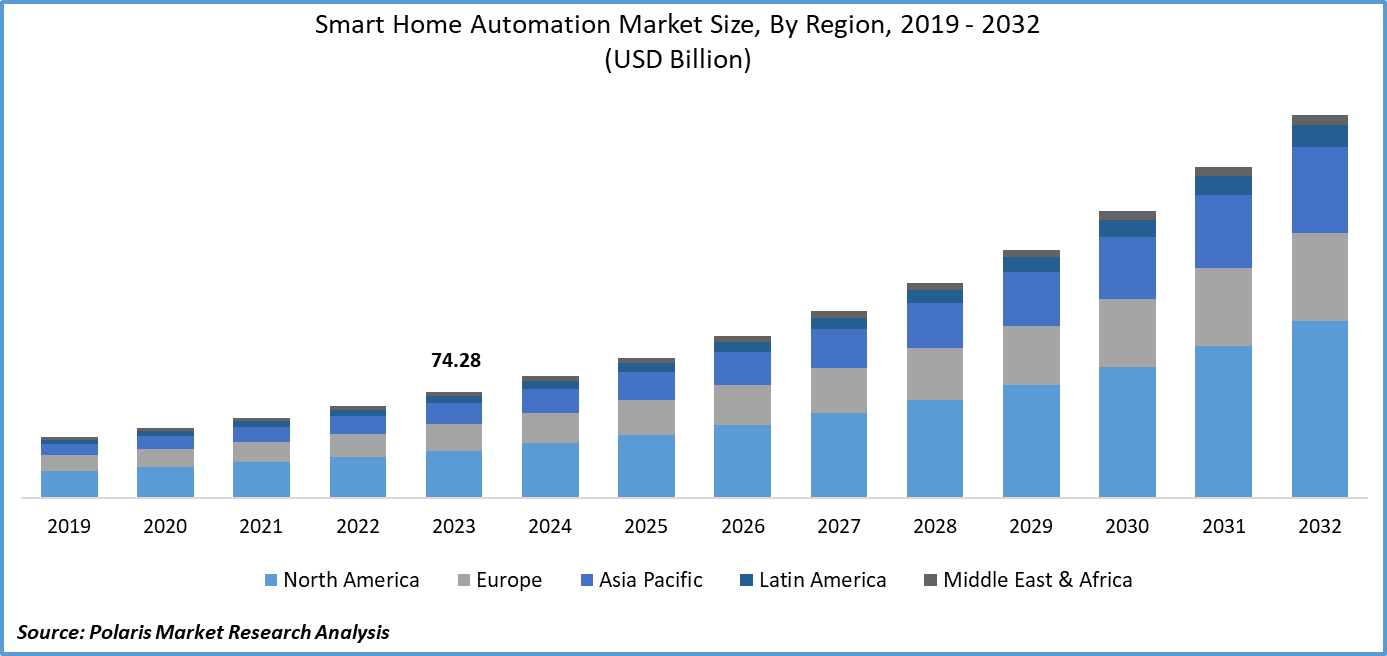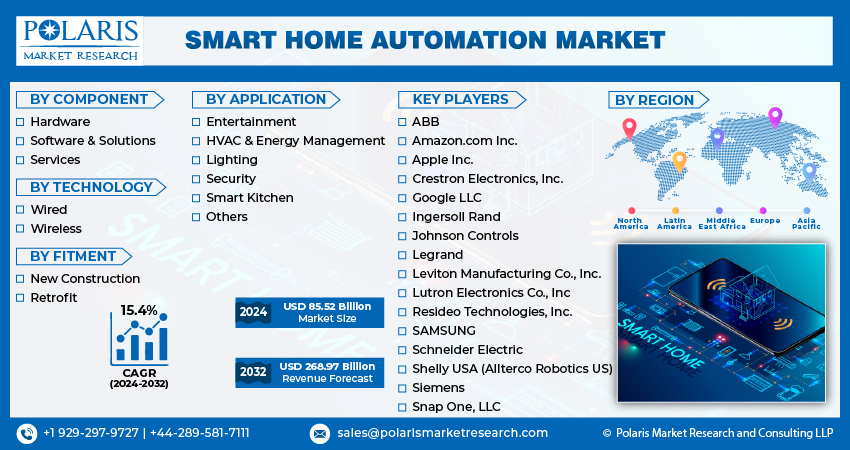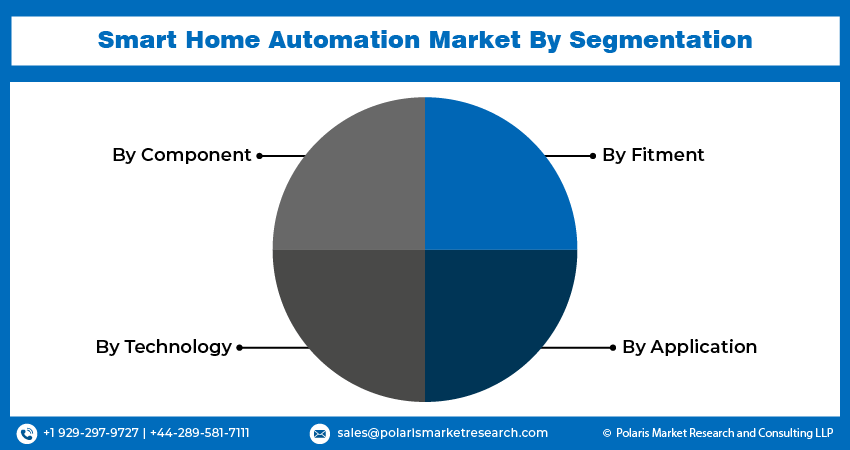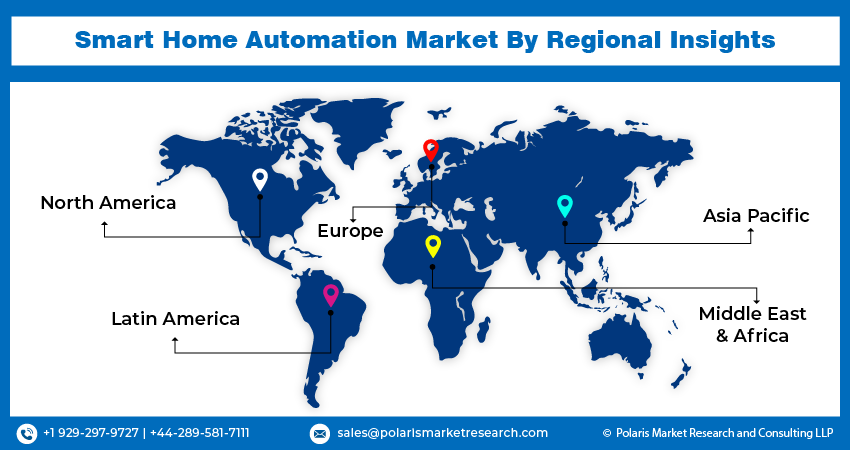
Smart Home Automation Market Share, Size, Trends, Industry Analysis Report By Component (Hardware, Software, Services) By Technology (Wired, Wireless) By Channel (Luxury, Mainstream, DIY, Managed) By Application (Lighting, Entertainment, Security and Access Control, HVAC, Others); By Regions, Segments & Forecast, 2024 - 2032
- Published Date:Mar-2024
- Pages: 115
- Format: PDF
- Report ID: PM1444
- Base Year: 2023
- Historical Data: 2019-2022
Report Outlook
Global smart home automation market size was valued at USD 74.28 billion in 2023. The market is anticipated to grow from USD 85.52 billion in 2024 to USD 268.97 billion by 2032, exhibiting a CAGR of 15.4% during the forecast period.
Industry Trends
Smart home automation refers to the integration of advanced technologies and interconnected devices within a household to allow centralized automation and control of various functions, such as lighting, heating, ventilation, air conditioning (HVAC), security, and entertainment systems. These systems utilize a combination of hardware, software, and networking technologies, including Internet of Things (IoT) devices, sensors, actuators, and communication protocols, to provide homeowners with greater convenience, comfort, energy efficiency, and security

To Understand More About this Research:Request a Free Sample Report
The smart home automation market has witnessed substantial growth in recent years, fueled by technological advancements, increasing consumer awareness about energy efficiency, and the growing adoption of smart devices. One of the prominent market trends is the proliferation of Internet of Things (IoT) technology. IoT-enabled devices facilitate seamless communication and interoperability among various smart devices, enhancing the overall efficiency and convenience of home automation systems. Furthermore, the integration of artificial intelligence (AI) and machine learning algorithms has enabled smart home systems to learn and adapt to users' preferences, thereby offering personalized experiences.
For instance, in March 2019, Domotron launched an innovative smart home hub that utilizes Artificial Intelligence (AI) to comprehend the users' preferences and create customized automation for their existing smart home devices with ease.
Also, the growing demand for connected and intelligent home security solutions is driving the adoption of smart home automation technologies. With rising concerns about safety and security, homeowners are investing in smart surveillance cameras, motion sensors, and smart locks, which are remotely monitored and controlled via smartphones or other connected devices.
Despite these growth prospects, the market faces certain challenges that impede its expansion. One primary concern is the high initial cost associated with installing smart home devices and systems. While the long-term benefits in terms of energy savings and convenience are significant, the upfront investment deters budget-conscious consumers, particularly in emerging economies.
Key Takeaways
- North America dominated the market and contributed over 42% market share of the smart home automation market size in 2023
- By component category, the hardware segment dominated the global smart home automation market size in 2023
- By application, the smart kitchen segment is projected to grow with a significant CAGR over the smart home automation market forecast period
Which Market Drivers are Driving the Market Demand?
The Advancements in Technology
Advancements in technology are key drivers behind the accelerating growth of the smart home automation market. With rapid progress in areas such as the Internet of Things (IoT), artificial intelligence (AI), and connectivity protocols, smart home devices are becoming increasingly sophisticated, interconnected, and intelligent. The Internet of Things (IoT) facilitates effortless communication and exchange of data among smart devices, enabling centralized control and automation of various home systems. This results in an interconnected network of devices that can be remotely controlled and monitored, bringing about greater convenience and efficiency in managing home systems. AI and machine learning algorithms empower these devices to learn user preferences, anticipate needs, and optimize performance over time, enhancing the overall user experience.
Also, advancements in wireless connectivity standards, such as Wi-Fi, Bluetooth, and Zigbee, ensure robust and reliable communication between devices, further expanding the possibilities for interconnected smart home ecosystems. As technology continues to evolve, driving down costs, improving efficiency, and unlocking new capabilities, the market is poised for continued growth and innovation, shaping the future of modern living.
Which Factor is Restraining the Smart Home Automation Demand?
Interoperability and Cybersecurity Concerns Are Hindering the Adoption of Smart Home Automation Systems and Consequently Limiting the Market’s Growth
The lack of standardized communication protocols and compatibility among devices from different manufacturers leads to interoperability issues, making it difficult for consumers to integrate various smart devices seamlessly within their home environments. This fragmentation limits the scalability and interoperability of smart home ecosystems, hindering the overall user experience and deterring potential adopters.
Also, cybersecurity threats, including hacking, data breaches, and privacy breaches, raise serious concerns about the safety and privacy of smart home data and systems. Security vulnerabilities erode consumer trust and confidence in smart home technologies, dampening enthusiasm for adoption. Thus, addressing these challenges through industry-wide collaboration, the development of robust security measures, and the establishment of interoperability standards is essential to alleviate concerns and unlock the full potential of the smart home automation market.

Report Segmentation
The market is primarily segmented based on component, technology, fitment, application, and region.
|
By Component |
By Technology |
By Fitment |
By Application |
By Region |
|
|
|
|
|
To Understand the Scope of this Report:Speak to Analyst
Category Wise Insights
By Component Insights
Based on component category analysis, the market has been segmented on the basis of hardware, software & solutions, and services. The hardware segment dominated the global smart home automation market size in 2023 due to the components such as smart sensors, actuators, hubs, and controllers form the foundational infrastructure of smart home automation systems, which are essential for enabling connectivity, control, and automation of various devices and systems within the home. As the adoption of smart home technologies continues to expand, there is a growing demand for these hardware components to build and enhance smart home ecosystems.
Also, advancements in hardware technology, including miniaturization, improved energy efficiency, and enhanced functionality, have made smart home devices more affordable, reliable, and accessible to consumers. Overall, the hardware segment's key role in enabling the deployment and functionality of smart home automation systems has propelled its dominance in the global market.
By Application Insights
Based on application category analysis, the market has been segmented on the basis of entertainment, HVAC & energy management, lighting, security, smart kitchen, and others. The smart kitchen segment is projected to experience substantial growth over the forecast period market due to the growing emphasis on convenience, efficiency, and connectivity in kitchen operations, which are driving the demand for smart kitchen appliances and devices that offer enhanced functionality and control. Smart kitchen solutions such as connected refrigerators, ovens, cooktops, and coffee makers enable users to remotely monitor and control cooking processes, access recipes, and receive real-time alerts and notifications. Also, the integration of IoT technology and artificial intelligence enables smart kitchen devices to learn user preferences, optimize energy usage, and suggest personalized recipes or cooking settings, further enhancing the user experience.
Along with this, changing consumer lifestyles, including busy schedules and a greater focus on health and wellness, are driving the adoption of smart kitchen solutions that streamline meal preparation, improve efficiency, and promote healthier cooking practices. These factors, coupled with ongoing innovations in smart kitchen technology and increasing consumer awareness, are expected to fuel the growth of the smart kitchen segment in the smart home automation market over the forecast period.

Regional Insights
North America
North America emerged as the dominant region in the market in 2023 since the region has witnessed widespread adoption of smart home technologies due to factors such as high disposable income levels, advanced infrastructure, and a tech-savvy consumer base. Also, the presence of major technology companies and innovative startups in the region has fueled the development and deployment of smart home solutions. Similarly, the region's robust ecosystem of retailers, distributors, and service providers specializing in smart home products and services has facilitated easy access and availability of these solutions to consumers. These factors, combined with a culture of early technology adoption and a growing awareness of the benefits of smart home automation, have propelled North America to the forefront of the global smart home automation market.
Asia Pacific
The market outlook in the Asia Pacific region is anticipated to experience substantial growth over the forecast period due to rapid urbanization and rising disposable incomes in countries such as China, India, Japan, and South Korea, which have fueled the demand for smart home technologies among a burgeoning middle-class population. As urban citizens seek greater convenience, comfort, and security in their homes, there is increasing adoption of smart home automation systems to streamline daily tasks and enhance quality of life. Further, the proliferation of smartphones, high-speed internet connectivity, and IoT-enabled devices has created a conducive environment for the adoption of smart home technologies, enabling seamless remote monitoring and control of home devices in the region. These factors are expected to fuel substantial growth in the smart home automation market in the Asia Pacific region.

Competitive Landscape
The market for smart home automation is highly competitive, with key players striving to innovate and differentiate their offerings to gain an edge. To develop advanced smart home solutions and platforms, major companies such as Google LLC, Amazon.com Inc., Apple Inc., and SAMSUNG are investing heavily in research and development. The smart home market is also seeing a proliferation of startups and emerging players that specialize in niche segments, which contributes to market dynamism and innovation. Companies often use partnerships, collaborations, and acquisitions to expand their product portfolios, enhance market presence, and capitalize on emerging opportunities.
Some of the major players operating in the global smart home automation market include
- ABB
- Amazon.com Inc.
- Apple Inc.
- Crestron Electronics, Inc.
- Google LLC
- Ingersoll Rand
- Johnson Controls
- Legrand
- Leviton Manufacturing Co., Inc.
- Lutron Electronics Co., Inc
- Resideo Technologies, Inc.
- SAMSUNG
- Schneider Electric
- Shelly USA (Allterco Robotics US)
- Siemens
- Snap One, LLC
Recent Developments
- In January 2023, Shelly, Allterco Robotics' division, unveiled eight new smart home automation devices at the Consumer Electronics Show (CES). Shelly released eight new devices in the Shelly Pro and series, which provide intelligent features for both professional installers and DIY homeowners.
- In October 2022, ABB unveiled its new SmartTouch 10” home automation device, a glass touch panel that integrates smart home automation and ABB-Welcome door communication into a single, user-friendly device.
- In March 2023, Johnson Controls launched a new security and smart home system called IQ4 NS (No Screen). This system is based on the IQ Panel 4 platform and is affordable at the entry-level.
Report Coverage
The smart home automation market report emphasizes key regions across the globe to provide users with a better understanding of the product. It also provides market insights into recent development and trends and analyzes the technologies that are gaining traction around the globe. Furthermore, the report covers an in-depth qualitative analysis pertaining to various paradigm shifts associated with the transformation of these solutions.
The report provides a detailed analysis of the market while focusing on various key aspects such as competitive analysis, components, technology, fitment, application, and their futuristic growth opportunities.
Smart Home Automation Market Report Scope
|
Report Attributes |
Details |
|
Market size value in 2024 |
USD 85.52 billion |
|
Revenue forecast in 2032 |
USD 268.97 billion |
|
CAGR |
15.4% from 2024 – 2032 |
|
Base year |
2023 |
|
Historical data |
2019 – 2022 |
|
Forecast period |
2024 – 2032 |
|
Quantitative units |
Revenue in USD billion and CAGR from 2024 to 2032 |
|
Segments covered |
By Component, By Technology, By Fitment, By Application, By Region |
|
Regional scope |
North America, Europe, Asia Pacific, Latin America, Middle East & Africa |
|
Customization |
Report customization as per your requirements with respect to countries, region, and segmentation. |
FAQ's
Key companies in the smart home automation market are ABB, Amazon.com Inc., Apple Inc., Crestron Electronics, Inc., Google LLC, Ingersoll Rand, Johnson Controls, Legrand, Leviton Manufacturing Co., Inc.
The smart home automation market exhibited a CAGR of 15.4% during the forecast period.
The key segments covered in the smart home automation market report are component, technology, fitment, application, and region.
The key driving factors in the smart home automation market are growing demand for connected and intelligent home security solutions.
The global smart home automation market size is expected to reach USD 268.97 billion by 2032.
